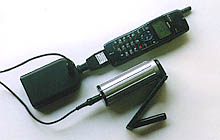HUMAN-POWERED ELECTRONICS:
The Latest Technology Relies on Primitive Energy Sources
November 18, 1999

This unit lets you charge cell-phone batteries with a couple minutes of toil. (3D International Co.)
New methods for powering portable digital equipment with such readily available energy sources as solar rays and human motion are coming into practical use. At first glance the words "digital" and "human powered" may seem quite incongruous. But today, with hand-held computing devices becoming essential communications tools, these new forms of power supply could be the perfect way to generate energy self-sufficiently while outdoors or in cases of emergency.
Two-Wheeled Communications
One person who has swiftly put this concept into practice is Noriyasu Kunori: He has fabricated a unique system of generating energy for his own assortment of compact digital machinery using his mountain bike. By mounting a rear-wheel light generator and a solar panel on the bike, Kunori can produce sufficient energy to power such equipment as cell phones, mobile computers, and digital cameras. And since energy obtained from his regular bike rides is stored in a battery, there is no need for him to spin his wheels every time he wants to use his mobile tools. He says that two hours of pedaling provides up to four AA batteries' worth of energy, enough to power a lightweight computer.
Kunori, 33, is a columnist writing for several computer magazines and a consultant on the development of mobile computing equipment. He uses his power-generating bike almost daily in his work, pedaling to assignments and sending data on location with his bike-powered computer. In winter 1997, moreover, he pedaled 340 kilometers (210 miles) through the severe cold of central Hokkaido, relaying the entire journey live using energy generated on his bicycle.
Energy Sources of Tomorrow
This movement toward self-sufficient power generation is by no means restricted to the domain of hard-core techies. For instance, a radio that has been on the market for several years features a built-in manual generator. By rotating its hand crank, the radio can be used without batteries, making it ideal for outdoors and emergency situations, as well as for energy-poor countries. A slew of easy-to-use generators that can power digital equipment have also been appearing one after another, most of which rely on either manual or solar power. Several variations of a battery charger with a hand crank, for example, have been coming out on the market since around 1998. These devices are about the size of a cellular phone. By working the crank one can repower several types of rechargable batteries: a three-minute charge of a cell phone battery yields three to ten minutes' worth of phone usage.
Meanwhile, a kit that relies on solar energy went on sale in May 1999. The set consists of a storage battery and a folding solar panel that are mounted onto a car, instantly transforming the vehicle into a mobile office. In fair weather it supplies energy sufficient for operating a personal computer.
Major foreign manufacturers are also actively pursuing the development of self-sufficient power generators for digital devices. One U.S. maker has developed a technology that draws on the minute energy created by the typing action on a computer keyboard to recharge the computer's battery. And a South African manufacturer has developed a power source that relies on the unwinding motion of springs that have been manually wound up.
The first calculators that came out about 30 years ago were powered through an electrical outlet. The power source was soon replaced by dry-cell batteries and then by solar energy. It looks as though it will only be a matter of time before items like cell phones and personal computers break free from electrical bondage and become self-sufficient in their own right.
 Edited
by Japan Echo Inc. based on domestic Japanese news sources. Articles presented
here are offered for reference purposes and do not necessarily represent
the policy or views of the Japanese Government.
| 



















